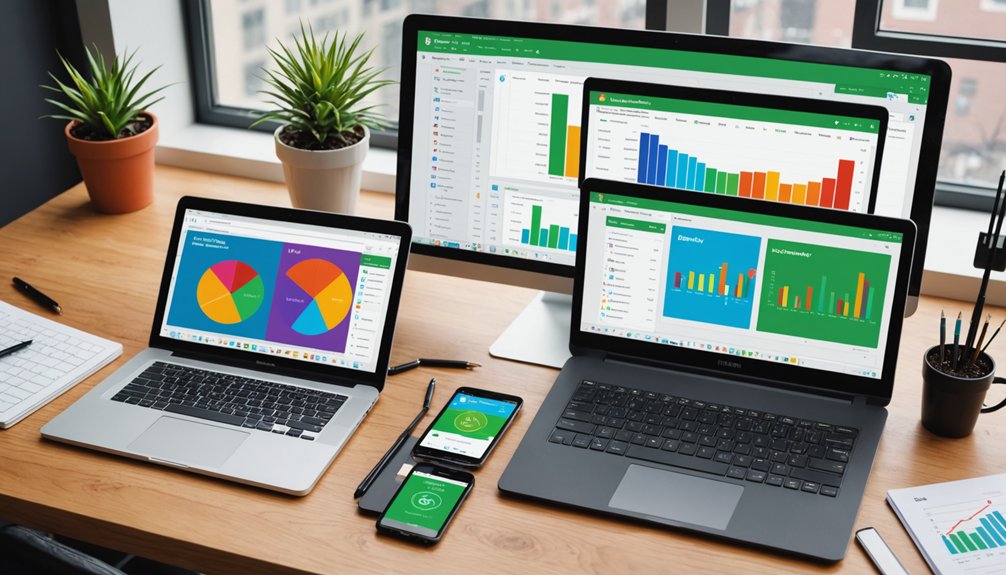Microsoft Copilot integrates AI assistance across Windows, Microsoft 365, and GitHub. It’s not just another chatbot. Powered by OpenAI’s GPT models, Copilot enhances productivity by generating content, creating slides, and visualizing data. The system learns from user behavior while maintaining privacy controls. It handles the mundane tasks so users can focus on what matters. Organizations love it for streamlining workflows and boosting collaboration. The full capabilities go much deeper than surface features.

Innovation moves fast. Microsoft’s latest AI offering, Copilot, is proof. It’s not just another chatbot. It’s an AI assistant that’s deeply integrated into Microsoft’s ecosystem, from Windows to Microsoft 365 and GitHub. Copilot leverages OpenAI’s GPT models to understand context, generate content, and automate tasks. Pretty impressive stuff.
What makes Copilot special? Integration. It’s embedded right into the tools you already use – Word, Excel, PowerPoint, Outlook. No need to switch between applications. It’s right there, ready to help. Business Chat takes things further by connecting to your data across Microsoft 365. That means smarter, more personalized assistance. No more generic responses. Similar to modern hyper-personalization tools, it analyzes user data to deliver tailored experiences.
Copilot isn’t just about productivity. It’s about creativity too. Writer’s block? Copilot can generate a draft to get you started. Need a presentation? Tell Copilot what you need, and it’ll create slides. Data analysis giving you headaches? Copilot can visualize data in Excel or Power BI. The AI handles the grunt work. You focus on what matters. Like advanced data analytics, it continuously learns from user behavior to improve its recommendations.
Let AI tackle the tedious tasks while you channel your creativity where it truly matters.
The technical side is equally impressive. Running on a combination of GPUs and CPUs, Copilot processes information through inference to generate original output. It taps into Microsoft Graph to analyze integrated data across applications. This isn’t simple pattern matching. It’s contextual understanding. The service efficiently utilizes advanced processing power from Intel and AMD CPUs equipped with neural processing units for optimal performance.
For businesses, Copilot is a game-changer. It streamlines workflows, automates routine tasks, and enhances collaboration in Teams. It learns your organization’s context and adapts to it. Your data becomes more useful. Your insights, more actionable. Syracuse University users can rest assured that their SU Copilot implementation maintains privacy by not retaining user data.
The best part? You’re always in control. Copilot suggests; you decide. It learns your writing style and preferences over time. The more you use it, the better it gets. It’s like having a smart assistant who actually pays attention.
Microsoft Copilot isn’t the future of work. It’s the present. And it’s already transforming how we interact with technology.
Frequently Asked Questions
How Much Does Microsoft Copilot Cost for Individual Users?
Microsoft Copilot comes in tiers for individual users.
The premium version, Copilot Pro, costs $20 per user monthly.
But there’s a catch—you’ll need Microsoft 365 too.
That’s another $6.99 monthly for Personal or $9.99 for Family plans (up to 6 users).
Total damage? Between $26.99 and $29.99 per month.
Some basic features are free, especially in Windows.
Advanced stuff? You’re paying.
Can Copilot Access My Private Company Data?
Yes, Copilot can access private company data. It taps into organizational content through Microsoft Graph—emails, calendars, documents, the works.
But relax, it’s not the Wild West. Users only see data they already have permission to view. No sneaking around Microsoft 365’s permission gates.
And get this: Copilot doesn’t use your corporate secrets to train its models. Users maintain control over what’s shared in each app.
Does Copilot Work Offline Without an Internet Connection?
No, Microsoft Copilot doesn’t work offline. Period.
It’s cloud-dependent, requiring internet access for all functions. The system processes tasks in Microsoft’s data centers via dark fiber connections, not locally on your device.
There’s no offline mode available currently. Copilot needs that web connection to access Azure services and handle API requests.
Want Copilot? Better have Wi-Fi or mobile data handy.
How Does Copilot Compare to Chatgpt or Google Gemini?
Copilot shines with Microsoft integration, making it the productivity king for Office users. Period.
ChatGPT? Conversation master with creative flair but lacks those sweet app connections.
Google Gemini leverages Google’s ecosystem—pretty impressive reach.
Each has its thing: Copilot for Microsoft-heavy businesses, ChatGPT for content creators wanting human-like interactions, and Gemini for Google devotees.
Different tools, different strengths. Pick your poison based on what you actually need.
What Privacy Concerns Should I Know About Using Copilot?
Privacy concerns with Copilot? There are several.
Data from Microsoft Graph gets used, though you can opt out of AI training. Everything’s encrypted in transit and at rest. They claim to anonymize your data.
Complies with GDPR, CCPA, and EU regulations, but watch for over-permissioning risks. Your stuff could get accessed if permissions aren’t managed right.
They delete data within 30 days if you opt out and your subscription ends.




